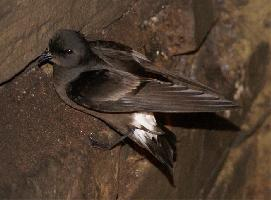
Poids et mesures
| Longueur | de 14 à 18 cm |
|---|---|
| Poids | de 23 à 29 g |
| Envergure des ailes | de 36 à 39 cm |
Données biologiques
| Durée de vie | 20 r |
|---|
Description de l'animal
The European storm petrel, scientifically known as Hydrobates pelagicus, is a captivating species of seabird belonging to the family Hydrobatidae. This small, yet resilient bird, is the smallest seabird found in the European region and is often shrouded in folklore and mystery, earning it various intriguing names across cultures, such as "Mother Carey's chicken" among British sailors.Physical Description:
The European storm petrel is diminutive in size, with a body length typically ranging from 14 to 18 centimeters, and a wingspan of about 36 to 39 centimeters. It weighs approximately 20 to 30 grams. The bird exhibits a predominantly black or dark brown plumage, which contrasts with a distinctive white rump and a square-tailed appearance. Its legs are relatively long and are equipped with webbed feet, which are essential for its semi-aquatic lifestyle. The bird's beak is sharp and well-adapted for seizing small prey from the ocean's surface.
Habitat and Distribution:
The European storm petrel is a pelagic species, spending most of its life far out at sea, only coming ashore to breed. It is widely distributed across the North Atlantic, including parts of the Mediterranean Sea. During the breeding season, these birds can be found nesting in colonies on remote islands, often selecting rocky crevices or burrows in which to lay their eggs. Outside of the breeding season, they are highly migratory, with some populations traveling to the South Atlantic to spend the winter.
Diet and Feeding Behavior:
This species primarily feeds on a diet of small fish, crustaceans, and cephalopods, which it picks from the sea surface while hovering or flying low over the water. Its nocturnal feeding habits help to avoid predation and competition for food resources. The European storm petrel has a unique gland located above its nasal passage, which helps it to process the saline seawater it ingests while feeding, excreting the excess salt through its nostrils.
Reproduction and Lifecycle:
European storm petrels are monogamous birds, often forming long-term pair bonds. They breed once a year, with the breeding season starting in late spring or early summer. The female typically lays a single white egg in a burrow or crevice, which both parents take turns incubating for about 40 to 60 days. After hatching, the chick is fed regurgitated food by both parents until it fledges approximately 60 to 70 days later. Despite their small size, these birds are relatively long-lived, with some individuals reaching ages of over 20 years.
Conservation Status:
Currently, the European storm petrel is classified as Least Concern by the International Union for Conservation of Nature (IUCN), indicating that it does not face any immediate threats of extinction. However, like many seabirds, it is vulnerable to pollution, climate change, and introduced predators on breeding islands. Conservation efforts are focused on protecting their breeding habitats and mitigating threats from human activities.
Cultural Significance:
The European storm petrel has long been a bird of legend and lore among sailors and coastal communities. Its appearance was often considered an omen of stormy weather, hence its name. Despite its small size, the European storm petrel embodies the resilience and mystery of the open ocean, continuing to fascinate and inspire those who encounter this remarkable bird.
Nouvelles photos d'animaux
Top 10 des animaux
- Dolphin gull (Leucophaeus scoresbii)
- Diana monkey (Cercopithecus diana)
- Moustached guenon (Cercopithecus cephus)
- Galápagos tortoise (Geochelone nigra complex)
- Russian tortoise (Testudo horsfieldii)
- Japanese macaque (Macaca fuscata)
- Stone loach (Barbatula barbatula)
- Greek tortoise (Testudo graeca)
- Common flying dragon (Draco volans)
- Colossal squid (Mesonychoteuthis hamiltoni)